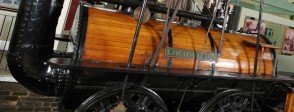Ask students to look closely at the images of Locomotive No.1 in order to deduce as much as they can about its purpose, how it moved and how it was powered. The key points to raise are that the engine was powered by coal burned to generate steam and that it ran on rails, hauling wagons loaded with goods and passenger carriages – images and video clips in For the classroom illustrate this.
Ask students to research the location of Etherley colliery, Witton colliery, the towns of Shildon and Stockton and the river Tees. Using this information, students can draw an approximate route of the Stockton and Darlington Railway. Discuss why the railways were built and why coal was being transported to the river Tees. What advantages did Locomotion No.1 have over horses, which had previously been used to transport coal?
Explain to students that the Stockton and Darlington Railway was a success because it transported goods and passengers. Why do students think people wanted to travel by railway? Ask students to write or draw predictions about what happened in Britain in the years following the successful opening of the Stockton and Darlington Railway. Invite students to compare their ideas to the actual development of the railways, starting with the images and objects in A bigger picture.
Study of the developments of the railways offers a variety of enquiry questions.
Did George Stephenson deserve to be called the ‘father of the railways’?
Students could begin by researching the explosion that killed Locomotion No.1’s driver using the Northern Echo article in For the classroom as a starting point. They could go on to investigate the development of locomotive design, including the Rocket. Once they are familiar with Stephenson’s work, students could examine the work of other engineers such as Robert Trevithick, James Watt, Joseph Locke and Isambard Kingdom Brunel. Introduce other factors outside innovation in engineering that contributed to the development of the railways.
Did all British people want the railways?
Students could start by using the sources in A bigger picture to examine the royal family’s enthusiasm for rail travel and its popularity among the broader population. It should surprise them that anyone might be against railways – try brainstorming as many reasons as the class can think of why people may be opposed. Introduce the Duke of Wellington’s comment and analyse it – introduce some examples of social unrest in the first half of the 1800s and consider what may be at the root of his comment. Students could go on to research reasons for opposition such as landowners resisting routes cutting through their property, farmers worried about the effect on their animals, those who thought that speed of travel was harmful to health, conservationists such as William Wordsworth.
How much does professional football today owe to Locomotion No.1?
Students could begin with the huge attendance at the 1901 FA Cup Final noting that it was between a team from London and a team from Yorkshire. Raise the question of how the Sheffield United fans got to London and how the Tottenham fans got from north to south London. Compare this with the attendance at the 1872 final and challenge the students to work out what had happened between the two dates. Identification of the railway companies that the fans used to travel will lead to several major figures of British engineering and from there to Stephenson and the Stockton and Darlington Railway.
Did the railways change people’s lives for better or for worse?
The video The world that railways made in For the classroom provides a useful starting point, summarising some negative aspects of the growth of the railways as well as the positives. Using links in For the classroom, students can go on to examine the impact of the railways, on, for example, work, leisure, health, homes, environment, communication.
Were railways Britain’s biggest gift to its empire?
The photo of the train in Nigeria in For the classroom makes an intriguing starting point. Establish from observation that there are both Europeans and Africans in attendance and discuss what the occasion might be and what clues there are that the occasion is ceremonial in some way – students may spot the British flags, the formal clothing and poses. Eagle-eyed students may be able to make out ‘Lagos’ on the carriages. The extra wheels in the foreground may give a clue that this was a place where train components were manufactured. Establish the context of the photo, then provide students with maps and other sources to help them identify the routes of railways in a selection of British colonies – there are good online resources for India, Kenya and Nigeria - and discuss the priorities for the British, whose principal concern was the transport of raw materials from the interior of territories to the ports, and what benefits or problems these presented for the indigenous populations.


